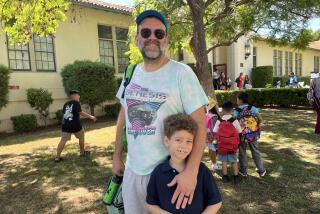Schooled in Roots of Jazz : Musicians Play a History Lesson, Teaching Youngsters to Feel the Thrill of an Art Form
The drummer went first, with a loud pulsating beat that instantly sent students rocking, clapping and dancing in their seats like they had just been given a jolt of electricity.
It was the sound of rap music.
Then quietly, subtly, the musicians began weaving their magic. And while the drummer continued to dominate, other instruments began filtering in--the bass, the piano, the sax and trumpet. Finally, it was clear that the musicians had made a switch, transforming the rap tune into a well-known number by the late, great Thelonious Monk.
It was the sound of jazz.
âRap music has its roots in jazz,â Washington Rucker told the young students at 59th Street Elementary School in the Crenshaw area. âJazz is the only true American art form.â
Origins of Jazz
Rucker and six other famed musicians took the young audience on a journey through the origins of jazz--from New Orleans and Dixieland to bebop, cool and fusion.
The musicians were well-known jazz performers, including Herman Riley on saxophone, Curtis Robertson Jr. on bass, Lanny Hartley on piano, Ndugo Chancler on drums, Ray Pizzi on reeds and Bobby Rodriguez on trumpet.
The âJazz Goes to Schoolâ program is sponsored by the Los Angeles Unified School District and the International Association of Jazz Appreciation. This is the second year the association has brought professional musicians to the school as part of an effort to build appreciation for the uniquely American art form.
The musicians have been performing free concerts at eight Los Angeles schools each week for the past seven weeks. The reason is simple:
âIn America, Jazz is not as commercial as other music forms. We go to Europe and Japan and we see children at concerts, but we donât see children when we perform here,â Rucker said. âWe have an obligation to reach the children because if we donât, this music will no longer be ours.â
Ruckerâs comments were echoed by City Councilwoman Ruth Galanter, who attended the performance and joined the dancing. âOne of the important things about going to school is that it ought to be a lot of fun and this is,â she said.
At times the scene in the small auditorium, packed with more than 200 students and teachers, resembled a revival as the musicians jammed, the students and teachers danced and the musicians played jazz standards, each demonstrating the powers of his instrument with a solo.
âMy grandfather used to play this kind of music,â said Dontrell Tobias, 12, as he rocked to the music. âIt makes you feel like dancing. My favorite is the blues.â
Alesha Domino, 10, jumped out of her seat and danced in the front of the auditorium. âI like it,â she said.
Yvonne Adams, a resource specialist for the school, said, âIt is not unusual for teachers to get up and start dancing with the musicians.â
âOde to a Toadâ
In addition to exposing the children to jazz, the musicians demonstrated how different instruments have been used in jazz. Musician Ray Pizzi, a reed specialist, entertained the group by playing a snappy tune called âOde to a Toadâ on a bassoon.
And when the group switched to the blues, the audience hit a new high. âThis is utter pandemonium,â said Arnell Harper, a member of the board of the International Assn. of Jazz Musicians. âIf we could put all this energy in one ball it could be more powerful than an atom bomb.â
Most of the musicians said they came to the school to perform because they felt the need to give something back to the community.
âI have a 6 1/2-year-old son and I recognize that it is difficult for kids today to get exposed to the music of yesterday,â said Chancler, a Grammy award-winning drummer. âI was exposed to it when I was young, but today the only way for them to be exposed to it is if the music is brought to them. Today all they see is MTV, and you know what they play.â
Trumpet player Rodriguez said it is important for youngsters to see musicians live.
Give Them Something
âThe kids love the music, but they donât know how to get there,â he said. âThey want a way out. I had a way out of the crap. And if we can give them a little something, just a little light to go for, then I think we have succeeded.â
However, getting out takes a lot of hard work, as Principal Cynthia Dugan reminded the children before they left the auditorium to âWhen The Saints Go Marching In.â
âWhat you must be able to understand is that it takes a lot of practice and perseverance to succeed,â she said. âWe want you to do as well with your studies and books as you did with the dances.â
More to Read
The biggest entertainment stories
Get our big stories about Hollywood, film, television, music, arts, culture and more right in your inbox as soon as they publish.
You may occasionally receive promotional content from the Los Angeles Times.










